RMIT ECON1010 Macroeconomics Assignment 1: Growth, Trade, and Jobs
VerifiedAdded on 2020/02/23
|6
|2709
|226
Homework Assignment
AI Summary
This assignment for ECON1010, Macroeconomics, explores key concepts such as unemployment, productivity and economic growth, and the financial system. It analyzes the impact of public and private savings, and national savings on loanable funds. The assignment also delves into the determinants of labor productivity, emphasizing the role of human capital. Furthermore, it examines the economic convergence of China and the United States and the role of free trade in emerging economies. The assignment also addresses the importance of inflation-adjusted per capita income. Finally, it analyzes the impact of automation and globalization on employment, drawing on a report on the future of work and discussing policy implications and industry-specific impacts.
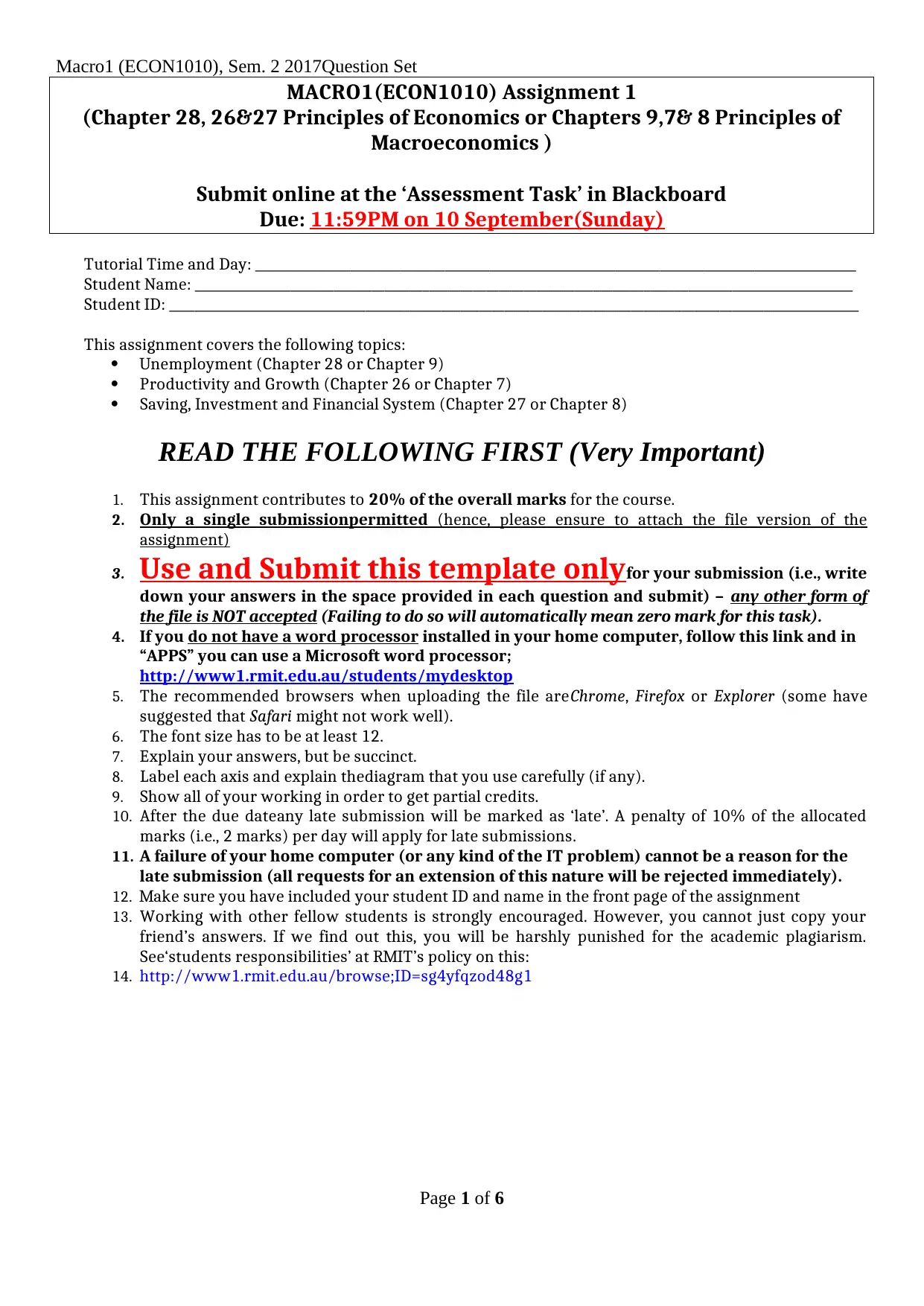
Macro1 (ECON1010), Sem. 2 2017Question Set
MACRO1(ECON1010) Assignment 1
(Chapter 28, 26&27 Principles of Economics or Chapters 9,7& 8 Principles of
Macroeconomics )
Submit online at the ‘Assessment Task’ in Blackboard
Due: 11:59PM on 10 September(Sunday)
Tutorial Time and Day: _______________________________________________________________________________________________
Student Name: ________________________________________________________________________________________________________
Student ID: _____________________________________________________________________________________________________________
This assignment covers the following topics:
Unemployment (Chapter 28 or Chapter 9)
Productivity and Growth (Chapter 26 or Chapter 7)
Saving, Investment and Financial System (Chapter 27 or Chapter 8)
READ THE FOLLOWING FIRST (Very Important)
1. This assignment contributes to 20% of the overall marks for the course.
2. Only a single submissionpermitted (hence, please ensure to attach the file version of the
assignment)
3. Use and Submit this template onlyfor your submission (i.e., write
down your answers in the space provided in each question and submit) – any other form of
the file is NOT accepted (Failing to do so will automatically mean zero mark for this task).
4. If you do not have a word processor installed in your home computer, follow this link and in
“APPS” you can use a Microsoft word processor;
http://www1.rmit.edu.au/students/mydesktop
5. The recommended browsers when uploading the file areChrome, Firefox or Explorer (some have
suggested that Safari might not work well).
6. The font size has to be at least 12.
7. Explain your answers, but be succinct.
8. Label each axis and explain thediagram that you use carefully (if any).
9. Show all of your working in order to get partial credits.
10. After the due dateany late submission will be marked as ‘late’. A penalty of 10% of the allocated
marks (i.e., 2 marks) per day will apply for late submissions.
11. A failure of your home computer (or any kind of the IT problem) cannot be a reason for the
late submission (all requests for an extension of this nature will be rejected immediately).
12. Make sure you have included your student ID and name in the front page of the assignment
13. Working with other fellow students is strongly encouraged. However, you cannot just copy your
friend’s answers. If we find out this, you will be harshly punished for the academic plagiarism.
See‘students responsibilities’ at RMIT’s policy on this:
14. http://www1.rmit.edu.au/browse;ID=sg4yfqzod48g1
Page 1 of 6
MACRO1(ECON1010) Assignment 1
(Chapter 28, 26&27 Principles of Economics or Chapters 9,7& 8 Principles of
Macroeconomics )
Submit online at the ‘Assessment Task’ in Blackboard
Due: 11:59PM on 10 September(Sunday)
Tutorial Time and Day: _______________________________________________________________________________________________
Student Name: ________________________________________________________________________________________________________
Student ID: _____________________________________________________________________________________________________________
This assignment covers the following topics:
Unemployment (Chapter 28 or Chapter 9)
Productivity and Growth (Chapter 26 or Chapter 7)
Saving, Investment and Financial System (Chapter 27 or Chapter 8)
READ THE FOLLOWING FIRST (Very Important)
1. This assignment contributes to 20% of the overall marks for the course.
2. Only a single submissionpermitted (hence, please ensure to attach the file version of the
assignment)
3. Use and Submit this template onlyfor your submission (i.e., write
down your answers in the space provided in each question and submit) – any other form of
the file is NOT accepted (Failing to do so will automatically mean zero mark for this task).
4. If you do not have a word processor installed in your home computer, follow this link and in
“APPS” you can use a Microsoft word processor;
http://www1.rmit.edu.au/students/mydesktop
5. The recommended browsers when uploading the file areChrome, Firefox or Explorer (some have
suggested that Safari might not work well).
6. The font size has to be at least 12.
7. Explain your answers, but be succinct.
8. Label each axis and explain thediagram that you use carefully (if any).
9. Show all of your working in order to get partial credits.
10. After the due dateany late submission will be marked as ‘late’. A penalty of 10% of the allocated
marks (i.e., 2 marks) per day will apply for late submissions.
11. A failure of your home computer (or any kind of the IT problem) cannot be a reason for the
late submission (all requests for an extension of this nature will be rejected immediately).
12. Make sure you have included your student ID and name in the front page of the assignment
13. Working with other fellow students is strongly encouraged. However, you cannot just copy your
friend’s answers. If we find out this, you will be harshly punished for the academic plagiarism.
See‘students responsibilities’ at RMIT’s policy on this:
14. http://www1.rmit.edu.au/browse;ID=sg4yfqzod48g1
Page 1 of 6
Paraphrase This Document
Need a fresh take? Get an instant paraphrase of this document with our AI Paraphraser
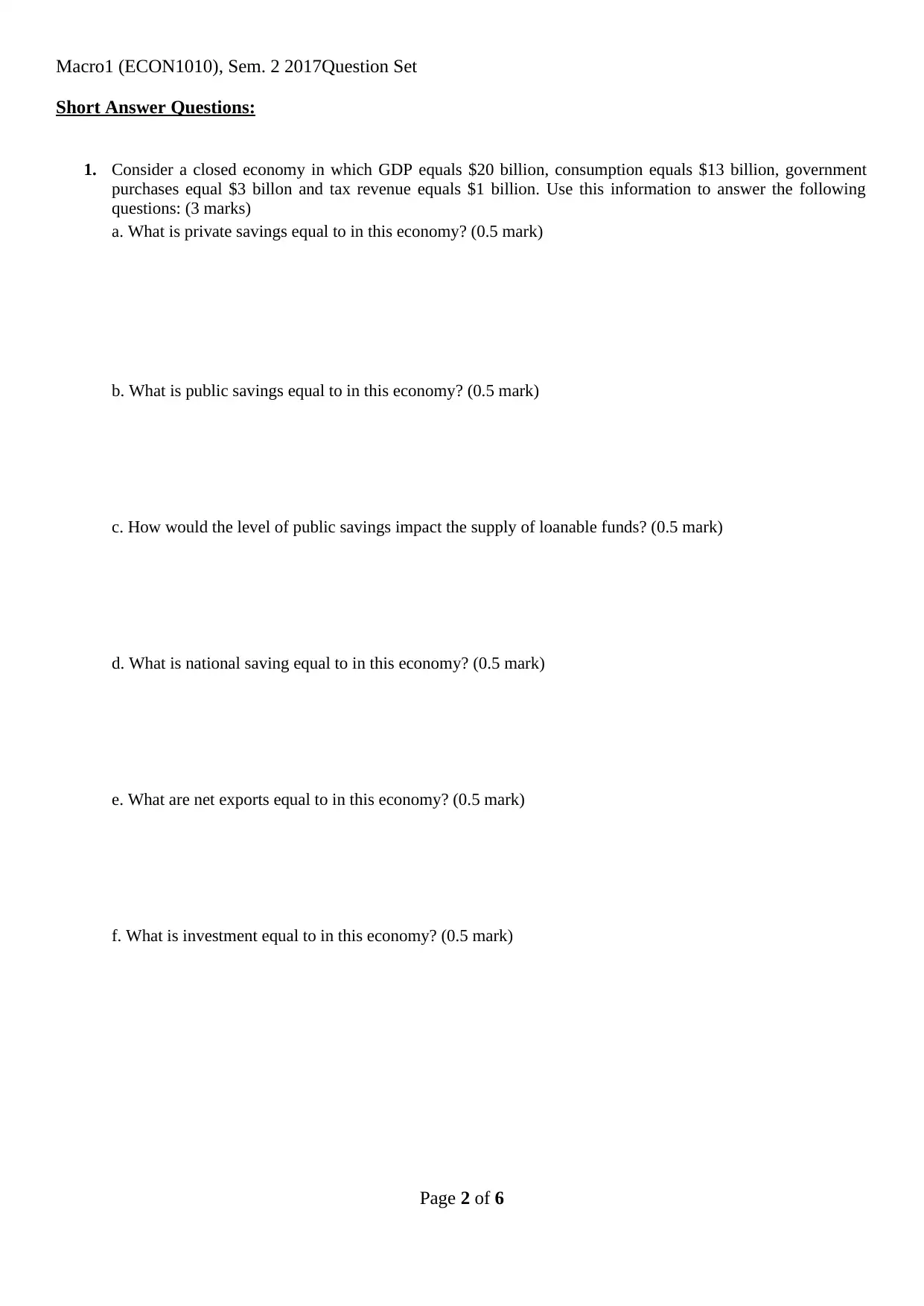
Macro1 (ECON1010), Sem. 2 2017Question Set
Short Answer Questions:
1. Consider a closed economy in which GDP equals $20 billion, consumption equals $13 billion, government
purchases equal $3 billon and tax revenue equals $1 billion. Use this information to answer the following
questions: (3 marks)
a. What is private savings equal to in this economy? (0.5 mark)
b. What is public savings equal to in this economy? (0.5 mark)
c. How would the level of public savings impact the supply of loanable funds? (0.5 mark)
d. What is national saving equal to in this economy? (0.5 mark)
e. What are net exports equal to in this economy? (0.5 mark)
f. What is investment equal to in this economy? (0.5 mark)
Page 2 of 6
Short Answer Questions:
1. Consider a closed economy in which GDP equals $20 billion, consumption equals $13 billion, government
purchases equal $3 billon and tax revenue equals $1 billion. Use this information to answer the following
questions: (3 marks)
a. What is private savings equal to in this economy? (0.5 mark)
b. What is public savings equal to in this economy? (0.5 mark)
c. How would the level of public savings impact the supply of loanable funds? (0.5 mark)
d. What is national saving equal to in this economy? (0.5 mark)
e. What are net exports equal to in this economy? (0.5 mark)
f. What is investment equal to in this economy? (0.5 mark)
Page 2 of 6
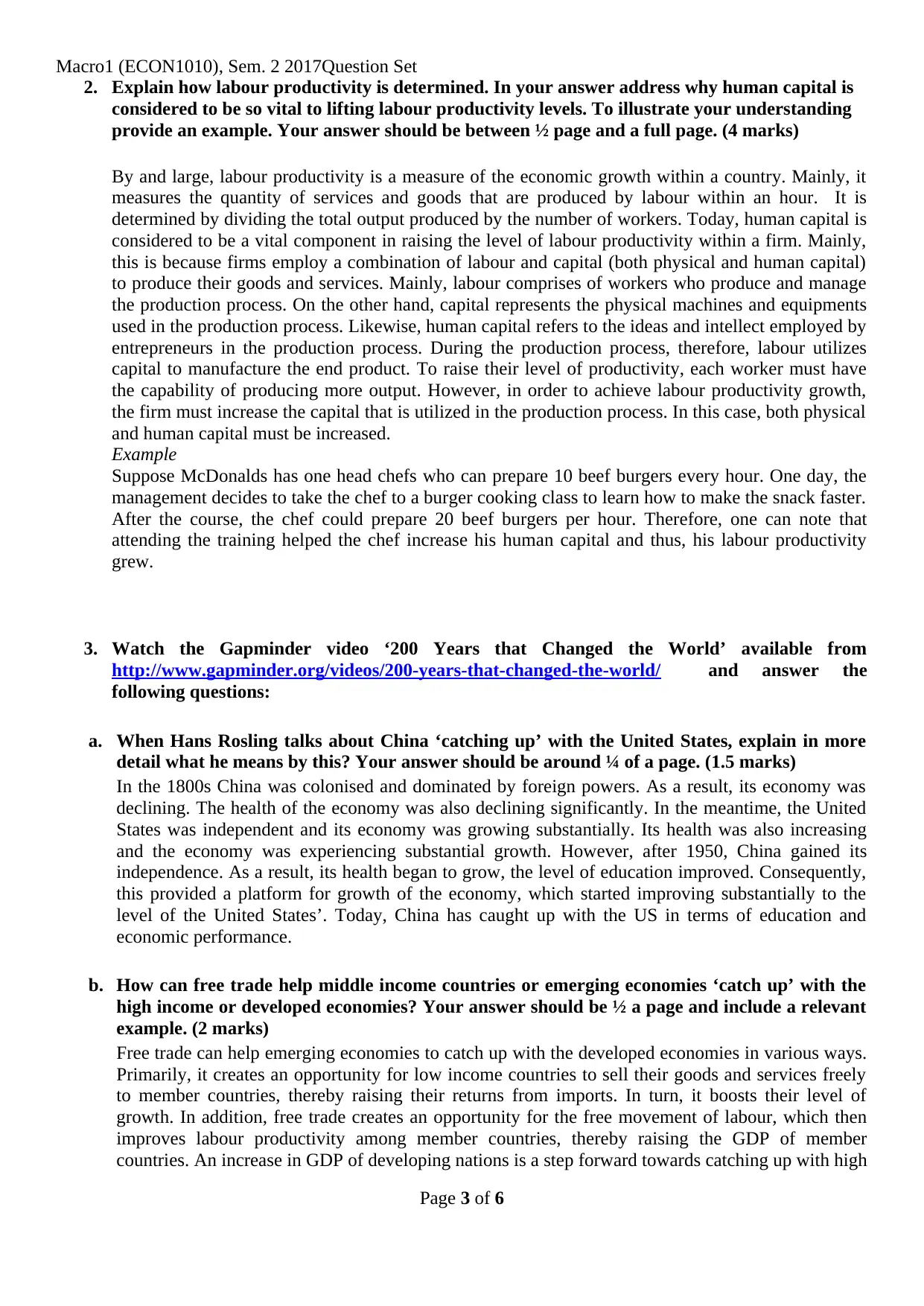
Macro1 (ECON1010), Sem. 2 2017Question Set
2. Explain how labour productivity is determined. In your answer address why human capital is
considered to be so vital to lifting labour productivity levels. To illustrate your understanding
provide an example. Your answer should be between ½ page and a full page. (4 marks)
By and large, labour productivity is a measure of the economic growth within a country. Mainly, it
measures the quantity of services and goods that are produced by labour within an hour. It is
determined by dividing the total output produced by the number of workers. Today, human capital is
considered to be a vital component in raising the level of labour productivity within a firm. Mainly,
this is because firms employ a combination of labour and capital (both physical and human capital)
to produce their goods and services. Mainly, labour comprises of workers who produce and manage
the production process. On the other hand, capital represents the physical machines and equipments
used in the production process. Likewise, human capital refers to the ideas and intellect employed by
entrepreneurs in the production process. During the production process, therefore, labour utilizes
capital to manufacture the end product. To raise their level of productivity, each worker must have
the capability of producing more output. However, in order to achieve labour productivity growth,
the firm must increase the capital that is utilized in the production process. In this case, both physical
and human capital must be increased.
Example
Suppose McDonalds has one head chefs who can prepare 10 beef burgers every hour. One day, the
management decides to take the chef to a burger cooking class to learn how to make the snack faster.
After the course, the chef could prepare 20 beef burgers per hour. Therefore, one can note that
attending the training helped the chef increase his human capital and thus, his labour productivity
grew.
3. Watch the Gapminder video ‘200 Years that Changed the World’ available from
http://www.gapminder.org/videos/200-years-that-changed-the-world/ and answer the
following questions:
a. When Hans Rosling talks about China ‘catching up’ with the United States, explain in more
detail what he means by this? Your answer should be around ¼ of a page. (1.5 marks)
In the 1800s China was colonised and dominated by foreign powers. As a result, its economy was
declining. The health of the economy was also declining significantly. In the meantime, the United
States was independent and its economy was growing substantially. Its health was also increasing
and the economy was experiencing substantial growth. However, after 1950, China gained its
independence. As a result, its health began to grow, the level of education improved. Consequently,
this provided a platform for growth of the economy, which started improving substantially to the
level of the United States’. Today, China has caught up with the US in terms of education and
economic performance.
b. How can free trade help middle income countries or emerging economies ‘catch up’ with the
high income or developed economies? Your answer should be ½ a page and include a relevant
example. (2 marks)
Free trade can help emerging economies to catch up with the developed economies in various ways.
Primarily, it creates an opportunity for low income countries to sell their goods and services freely
to member countries, thereby raising their returns from imports. In turn, it boosts their level of
growth. In addition, free trade creates an opportunity for the free movement of labour, which then
improves labour productivity among member countries, thereby raising the GDP of member
countries. An increase in GDP of developing nations is a step forward towards catching up with high
Page 3 of 6
2. Explain how labour productivity is determined. In your answer address why human capital is
considered to be so vital to lifting labour productivity levels. To illustrate your understanding
provide an example. Your answer should be between ½ page and a full page. (4 marks)
By and large, labour productivity is a measure of the economic growth within a country. Mainly, it
measures the quantity of services and goods that are produced by labour within an hour. It is
determined by dividing the total output produced by the number of workers. Today, human capital is
considered to be a vital component in raising the level of labour productivity within a firm. Mainly,
this is because firms employ a combination of labour and capital (both physical and human capital)
to produce their goods and services. Mainly, labour comprises of workers who produce and manage
the production process. On the other hand, capital represents the physical machines and equipments
used in the production process. Likewise, human capital refers to the ideas and intellect employed by
entrepreneurs in the production process. During the production process, therefore, labour utilizes
capital to manufacture the end product. To raise their level of productivity, each worker must have
the capability of producing more output. However, in order to achieve labour productivity growth,
the firm must increase the capital that is utilized in the production process. In this case, both physical
and human capital must be increased.
Example
Suppose McDonalds has one head chefs who can prepare 10 beef burgers every hour. One day, the
management decides to take the chef to a burger cooking class to learn how to make the snack faster.
After the course, the chef could prepare 20 beef burgers per hour. Therefore, one can note that
attending the training helped the chef increase his human capital and thus, his labour productivity
grew.
3. Watch the Gapminder video ‘200 Years that Changed the World’ available from
http://www.gapminder.org/videos/200-years-that-changed-the-world/ and answer the
following questions:
a. When Hans Rosling talks about China ‘catching up’ with the United States, explain in more
detail what he means by this? Your answer should be around ¼ of a page. (1.5 marks)
In the 1800s China was colonised and dominated by foreign powers. As a result, its economy was
declining. The health of the economy was also declining significantly. In the meantime, the United
States was independent and its economy was growing substantially. Its health was also increasing
and the economy was experiencing substantial growth. However, after 1950, China gained its
independence. As a result, its health began to grow, the level of education improved. Consequently,
this provided a platform for growth of the economy, which started improving substantially to the
level of the United States’. Today, China has caught up with the US in terms of education and
economic performance.
b. How can free trade help middle income countries or emerging economies ‘catch up’ with the
high income or developed economies? Your answer should be ½ a page and include a relevant
example. (2 marks)
Free trade can help emerging economies to catch up with the developed economies in various ways.
Primarily, it creates an opportunity for low income countries to sell their goods and services freely
to member countries, thereby raising their returns from imports. In turn, it boosts their level of
growth. In addition, free trade creates an opportunity for the free movement of labour, which then
improves labour productivity among member countries, thereby raising the GDP of member
countries. An increase in GDP of developing nations is a step forward towards catching up with high
Page 3 of 6
⊘ This is a preview!⊘
Do you want full access?
Subscribe today to unlock all pages.

Trusted by 1+ million students worldwide
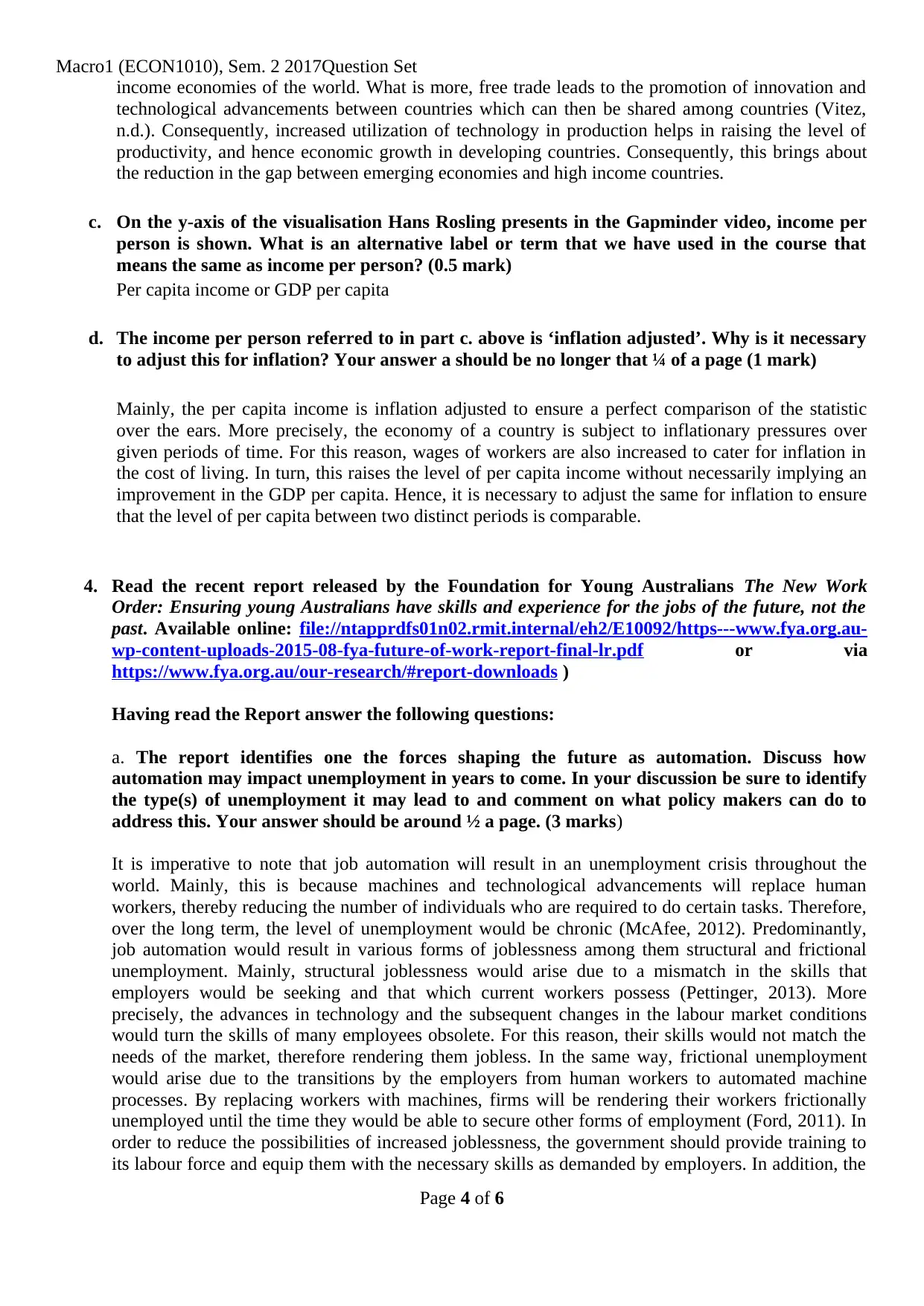
Macro1 (ECON1010), Sem. 2 2017Question Set
income economies of the world. What is more, free trade leads to the promotion of innovation and
technological advancements between countries which can then be shared among countries (Vitez,
n.d.). Consequently, increased utilization of technology in production helps in raising the level of
productivity, and hence economic growth in developing countries. Consequently, this brings about
the reduction in the gap between emerging economies and high income countries.
c. On the y-axis of the visualisation Hans Rosling presents in the Gapminder video, income per
person is shown. What is an alternative label or term that we have used in the course that
means the same as income per person? (0.5 mark)
Per capita income or GDP per capita
d. The income per person referred to in part c. above is ‘inflation adjusted’. Why is it necessary
to adjust this for inflation? Your answer a should be no longer that ¼ of a page (1 mark)
Mainly, the per capita income is inflation adjusted to ensure a perfect comparison of the statistic
over the ears. More precisely, the economy of a country is subject to inflationary pressures over
given periods of time. For this reason, wages of workers are also increased to cater for inflation in
the cost of living. In turn, this raises the level of per capita income without necessarily implying an
improvement in the GDP per capita. Hence, it is necessary to adjust the same for inflation to ensure
that the level of per capita between two distinct periods is comparable.
4. Read the recent report released by the Foundation for Young Australians The New Work
Order: Ensuring young Australians have skills and experience for the jobs of the future, not the
past. Available online: file://ntapprdfs01n02.rmit.internal/eh2/E10092/https---www.fya.org.au-
wp-content-uploads-2015-08-fya-future-of-work-report-final-lr.pdf or via
https://www.fya.org.au/our-research/#report-downloads )
Having read the Report answer the following questions:
a. The report identifies one the forces shaping the future as automation. Discuss how
automation may impact unemployment in years to come. In your discussion be sure to identify
the type(s) of unemployment it may lead to and comment on what policy makers can do to
address this. Your answer should be around ½ a page. (3 marks)
It is imperative to note that job automation will result in an unemployment crisis throughout the
world. Mainly, this is because machines and technological advancements will replace human
workers, thereby reducing the number of individuals who are required to do certain tasks. Therefore,
over the long term, the level of unemployment would be chronic (McAfee, 2012). Predominantly,
job automation would result in various forms of joblessness among them structural and frictional
unemployment. Mainly, structural joblessness would arise due to a mismatch in the skills that
employers would be seeking and that which current workers possess (Pettinger, 2013). More
precisely, the advances in technology and the subsequent changes in the labour market conditions
would turn the skills of many employees obsolete. For this reason, their skills would not match the
needs of the market, therefore rendering them jobless. In the same way, frictional unemployment
would arise due to the transitions by the employers from human workers to automated machine
processes. By replacing workers with machines, firms will be rendering their workers frictionally
unemployed until the time they would be able to secure other forms of employment (Ford, 2011). In
order to reduce the possibilities of increased joblessness, the government should provide training to
its labour force and equip them with the necessary skills as demanded by employers. In addition, the
Page 4 of 6
income economies of the world. What is more, free trade leads to the promotion of innovation and
technological advancements between countries which can then be shared among countries (Vitez,
n.d.). Consequently, increased utilization of technology in production helps in raising the level of
productivity, and hence economic growth in developing countries. Consequently, this brings about
the reduction in the gap between emerging economies and high income countries.
c. On the y-axis of the visualisation Hans Rosling presents in the Gapminder video, income per
person is shown. What is an alternative label or term that we have used in the course that
means the same as income per person? (0.5 mark)
Per capita income or GDP per capita
d. The income per person referred to in part c. above is ‘inflation adjusted’. Why is it necessary
to adjust this for inflation? Your answer a should be no longer that ¼ of a page (1 mark)
Mainly, the per capita income is inflation adjusted to ensure a perfect comparison of the statistic
over the ears. More precisely, the economy of a country is subject to inflationary pressures over
given periods of time. For this reason, wages of workers are also increased to cater for inflation in
the cost of living. In turn, this raises the level of per capita income without necessarily implying an
improvement in the GDP per capita. Hence, it is necessary to adjust the same for inflation to ensure
that the level of per capita between two distinct periods is comparable.
4. Read the recent report released by the Foundation for Young Australians The New Work
Order: Ensuring young Australians have skills and experience for the jobs of the future, not the
past. Available online: file://ntapprdfs01n02.rmit.internal/eh2/E10092/https---www.fya.org.au-
wp-content-uploads-2015-08-fya-future-of-work-report-final-lr.pdf or via
https://www.fya.org.au/our-research/#report-downloads )
Having read the Report answer the following questions:
a. The report identifies one the forces shaping the future as automation. Discuss how
automation may impact unemployment in years to come. In your discussion be sure to identify
the type(s) of unemployment it may lead to and comment on what policy makers can do to
address this. Your answer should be around ½ a page. (3 marks)
It is imperative to note that job automation will result in an unemployment crisis throughout the
world. Mainly, this is because machines and technological advancements will replace human
workers, thereby reducing the number of individuals who are required to do certain tasks. Therefore,
over the long term, the level of unemployment would be chronic (McAfee, 2012). Predominantly,
job automation would result in various forms of joblessness among them structural and frictional
unemployment. Mainly, structural joblessness would arise due to a mismatch in the skills that
employers would be seeking and that which current workers possess (Pettinger, 2013). More
precisely, the advances in technology and the subsequent changes in the labour market conditions
would turn the skills of many employees obsolete. For this reason, their skills would not match the
needs of the market, therefore rendering them jobless. In the same way, frictional unemployment
would arise due to the transitions by the employers from human workers to automated machine
processes. By replacing workers with machines, firms will be rendering their workers frictionally
unemployed until the time they would be able to secure other forms of employment (Ford, 2011). In
order to reduce the possibilities of increased joblessness, the government should provide training to
its labour force and equip them with the necessary skills as demanded by employers. In addition, the
Page 4 of 6
Paraphrase This Document
Need a fresh take? Get an instant paraphrase of this document with our AI Paraphraser
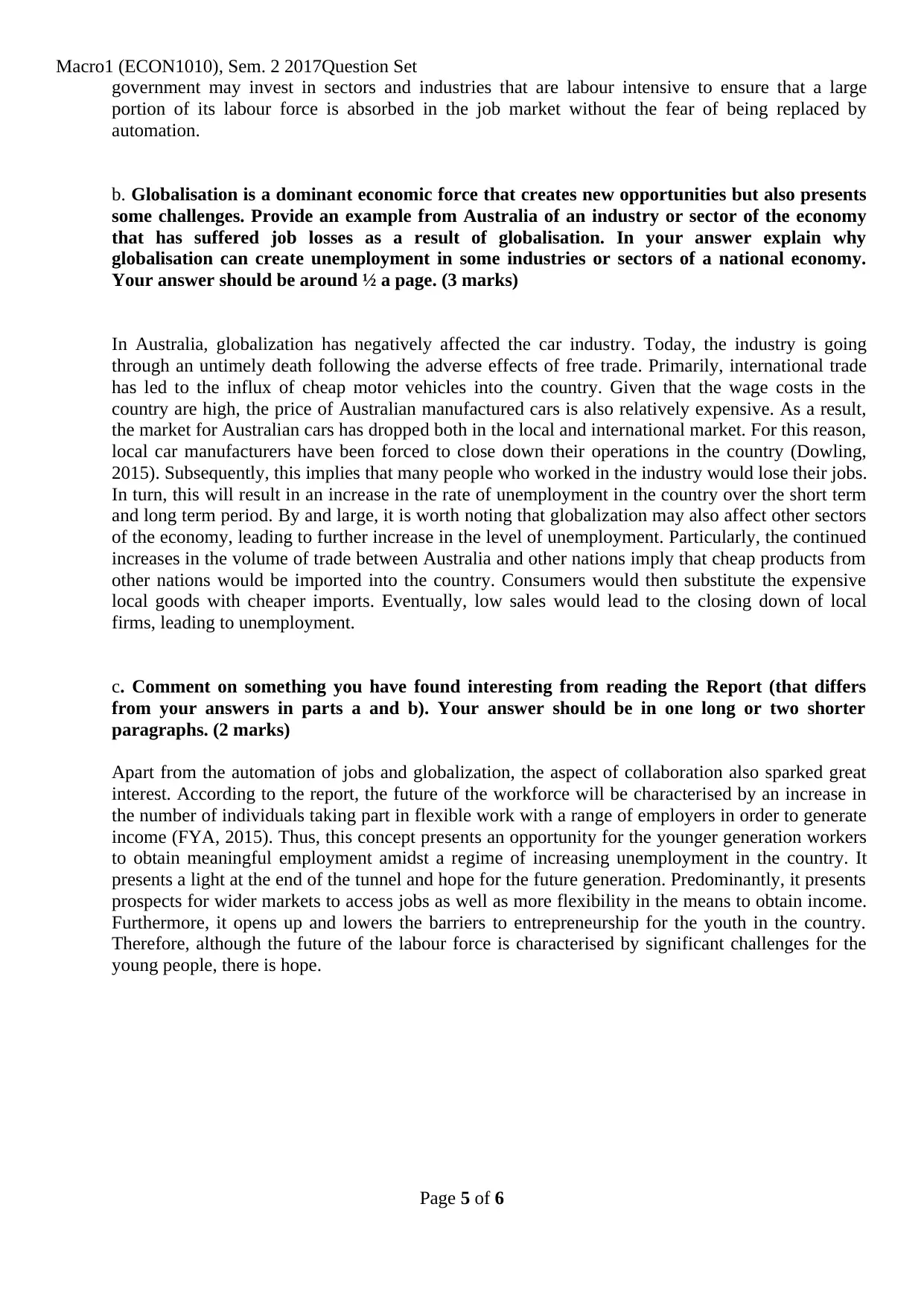
Macro1 (ECON1010), Sem. 2 2017Question Set
government may invest in sectors and industries that are labour intensive to ensure that a large
portion of its labour force is absorbed in the job market without the fear of being replaced by
automation.
b. Globalisation is a dominant economic force that creates new opportunities but also presents
some challenges. Provide an example from Australia of an industry or sector of the economy
that has suffered job losses as a result of globalisation. In your answer explain why
globalisation can create unemployment in some industries or sectors of a national economy.
Your answer should be around ½ a page. (3 marks)
In Australia, globalization has negatively affected the car industry. Today, the industry is going
through an untimely death following the adverse effects of free trade. Primarily, international trade
has led to the influx of cheap motor vehicles into the country. Given that the wage costs in the
country are high, the price of Australian manufactured cars is also relatively expensive. As a result,
the market for Australian cars has dropped both in the local and international market. For this reason,
local car manufacturers have been forced to close down their operations in the country (Dowling,
2015). Subsequently, this implies that many people who worked in the industry would lose their jobs.
In turn, this will result in an increase in the rate of unemployment in the country over the short term
and long term period. By and large, it is worth noting that globalization may also affect other sectors
of the economy, leading to further increase in the level of unemployment. Particularly, the continued
increases in the volume of trade between Australia and other nations imply that cheap products from
other nations would be imported into the country. Consumers would then substitute the expensive
local goods with cheaper imports. Eventually, low sales would lead to the closing down of local
firms, leading to unemployment.
c. Comment on something you have found interesting from reading the Report (that differs
from your answers in parts a and b). Your answer should be in one long or two shorter
paragraphs. (2 marks)
Apart from the automation of jobs and globalization, the aspect of collaboration also sparked great
interest. According to the report, the future of the workforce will be characterised by an increase in
the number of individuals taking part in flexible work with a range of employers in order to generate
income (FYA, 2015). Thus, this concept presents an opportunity for the younger generation workers
to obtain meaningful employment amidst a regime of increasing unemployment in the country. It
presents a light at the end of the tunnel and hope for the future generation. Predominantly, it presents
prospects for wider markets to access jobs as well as more flexibility in the means to obtain income.
Furthermore, it opens up and lowers the barriers to entrepreneurship for the youth in the country.
Therefore, although the future of the labour force is characterised by significant challenges for the
young people, there is hope.
Page 5 of 6
government may invest in sectors and industries that are labour intensive to ensure that a large
portion of its labour force is absorbed in the job market without the fear of being replaced by
automation.
b. Globalisation is a dominant economic force that creates new opportunities but also presents
some challenges. Provide an example from Australia of an industry or sector of the economy
that has suffered job losses as a result of globalisation. In your answer explain why
globalisation can create unemployment in some industries or sectors of a national economy.
Your answer should be around ½ a page. (3 marks)
In Australia, globalization has negatively affected the car industry. Today, the industry is going
through an untimely death following the adverse effects of free trade. Primarily, international trade
has led to the influx of cheap motor vehicles into the country. Given that the wage costs in the
country are high, the price of Australian manufactured cars is also relatively expensive. As a result,
the market for Australian cars has dropped both in the local and international market. For this reason,
local car manufacturers have been forced to close down their operations in the country (Dowling,
2015). Subsequently, this implies that many people who worked in the industry would lose their jobs.
In turn, this will result in an increase in the rate of unemployment in the country over the short term
and long term period. By and large, it is worth noting that globalization may also affect other sectors
of the economy, leading to further increase in the level of unemployment. Particularly, the continued
increases in the volume of trade between Australia and other nations imply that cheap products from
other nations would be imported into the country. Consumers would then substitute the expensive
local goods with cheaper imports. Eventually, low sales would lead to the closing down of local
firms, leading to unemployment.
c. Comment on something you have found interesting from reading the Report (that differs
from your answers in parts a and b). Your answer should be in one long or two shorter
paragraphs. (2 marks)
Apart from the automation of jobs and globalization, the aspect of collaboration also sparked great
interest. According to the report, the future of the workforce will be characterised by an increase in
the number of individuals taking part in flexible work with a range of employers in order to generate
income (FYA, 2015). Thus, this concept presents an opportunity for the younger generation workers
to obtain meaningful employment amidst a regime of increasing unemployment in the country. It
presents a light at the end of the tunnel and hope for the future generation. Predominantly, it presents
prospects for wider markets to access jobs as well as more flexibility in the means to obtain income.
Furthermore, it opens up and lowers the barriers to entrepreneurship for the youth in the country.
Therefore, although the future of the labour force is characterised by significant challenges for the
young people, there is hope.
Page 5 of 6
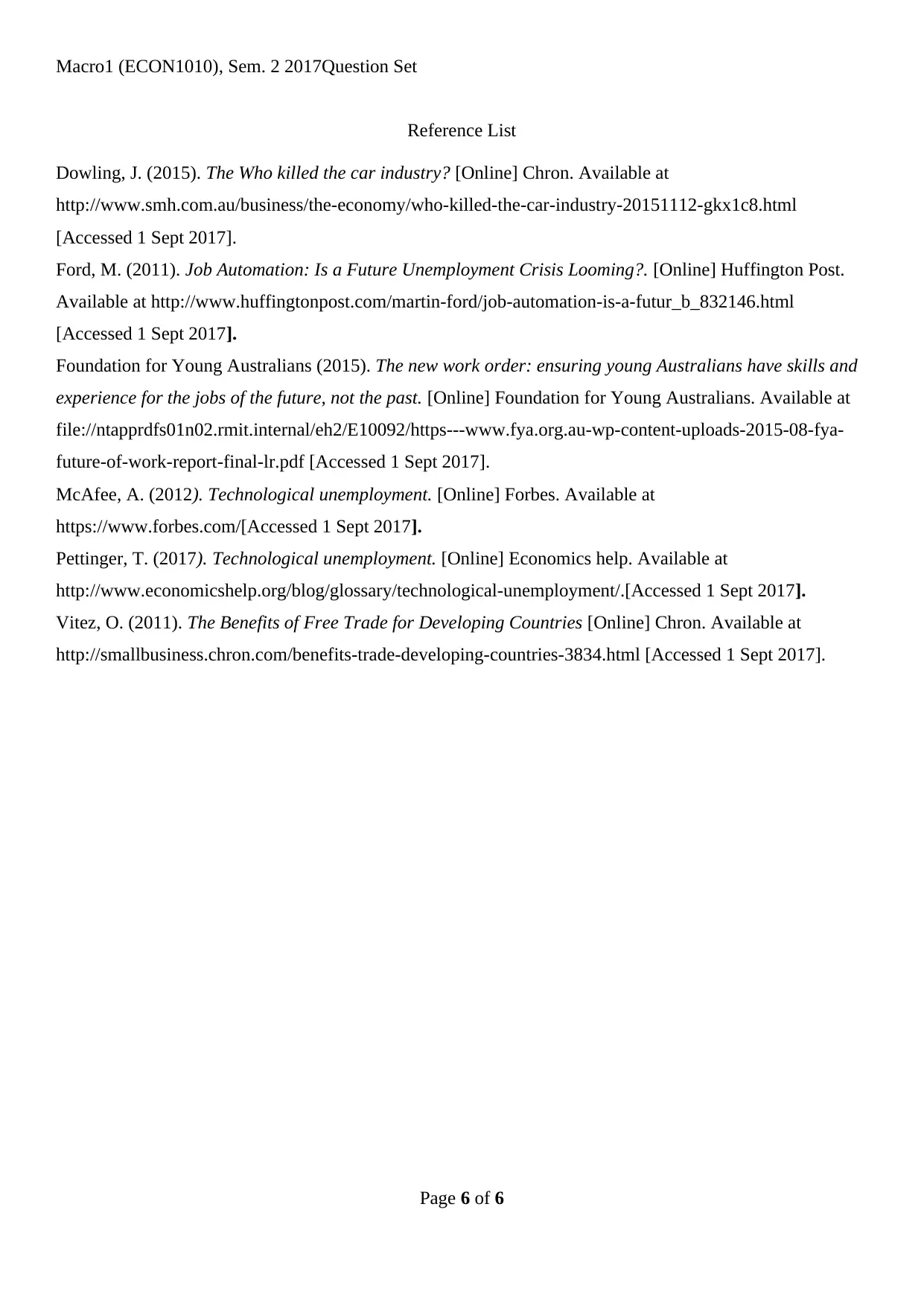
Macro1 (ECON1010), Sem. 2 2017Question Set
Reference List
Dowling, J. (2015). The Who killed the car industry? [Online] Chron. Available at
http://www.smh.com.au/business/the-economy/who-killed-the-car-industry-20151112-gkx1c8.html
[Accessed 1 Sept 2017].
Ford, M. (2011). Job Automation: Is a Future Unemployment Crisis Looming?. [Online] Huffington Post.
Available at http://www.huffingtonpost.com/martin-ford/job-automation-is-a-futur_b_832146.html
[Accessed 1 Sept 2017].
Foundation for Young Australians (2015). The new work order: ensuring young Australians have skills and
experience for the jobs of the future, not the past. [Online] Foundation for Young Australians. Available at
file://ntapprdfs01n02.rmit.internal/eh2/E10092/https---www.fya.org.au-wp-content-uploads-2015-08-fya-
future-of-work-report-final-lr.pdf [Accessed 1 Sept 2017].
McAfee, A. (2012). Technological unemployment. [Online] Forbes. Available at
https://www.forbes.com/[Accessed 1 Sept 2017].
Pettinger, T. (2017). Technological unemployment. [Online] Economics help. Available at
http://www.economicshelp.org/blog/glossary/technological-unemployment/.[Accessed 1 Sept 2017].
Vitez, O. (2011). The Benefits of Free Trade for Developing Countries [Online] Chron. Available at
http://smallbusiness.chron.com/benefits-trade-developing-countries-3834.html [Accessed 1 Sept 2017].
Page 6 of 6
Reference List
Dowling, J. (2015). The Who killed the car industry? [Online] Chron. Available at
http://www.smh.com.au/business/the-economy/who-killed-the-car-industry-20151112-gkx1c8.html
[Accessed 1 Sept 2017].
Ford, M. (2011). Job Automation: Is a Future Unemployment Crisis Looming?. [Online] Huffington Post.
Available at http://www.huffingtonpost.com/martin-ford/job-automation-is-a-futur_b_832146.html
[Accessed 1 Sept 2017].
Foundation for Young Australians (2015). The new work order: ensuring young Australians have skills and
experience for the jobs of the future, not the past. [Online] Foundation for Young Australians. Available at
file://ntapprdfs01n02.rmit.internal/eh2/E10092/https---www.fya.org.au-wp-content-uploads-2015-08-fya-
future-of-work-report-final-lr.pdf [Accessed 1 Sept 2017].
McAfee, A. (2012). Technological unemployment. [Online] Forbes. Available at
https://www.forbes.com/[Accessed 1 Sept 2017].
Pettinger, T. (2017). Technological unemployment. [Online] Economics help. Available at
http://www.economicshelp.org/blog/glossary/technological-unemployment/.[Accessed 1 Sept 2017].
Vitez, O. (2011). The Benefits of Free Trade for Developing Countries [Online] Chron. Available at
http://smallbusiness.chron.com/benefits-trade-developing-countries-3834.html [Accessed 1 Sept 2017].
Page 6 of 6
⊘ This is a preview!⊘
Do you want full access?
Subscribe today to unlock all pages.

Trusted by 1+ million students worldwide
1 out of 6
Related Documents
Your All-in-One AI-Powered Toolkit for Academic Success.
+13062052269
info@desklib.com
Available 24*7 on WhatsApp / Email
![[object Object]](/_next/static/media/star-bottom.7253800d.svg)
Unlock your academic potential
Copyright © 2020–2025 A2Z Services. All Rights Reserved. Developed and managed by ZUCOL.





